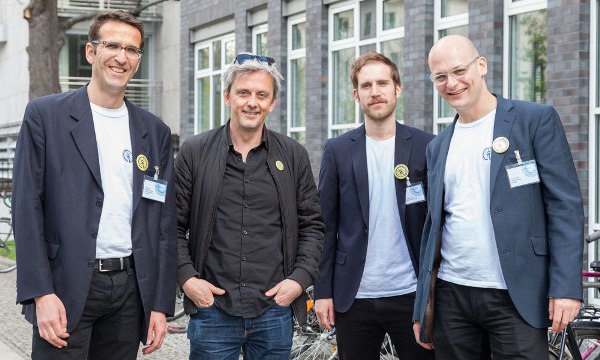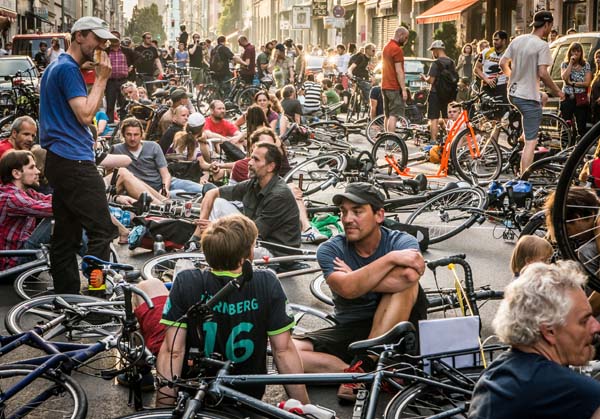Berlin’s Volksentscheid Fahrrad initiative (VEF), launched in November 2015, has within a very short time kindled an unprecedented public debate about cycling. The “Radentscheid” has become a perennial favourite of the Berlin media (see Media Coverage) and is now recognised in Germany and even internationally. Reason enough for Bremenize to look at what has happened in Berlin since its formation, and what we can learn for ourselves. Should we consider a similar initiative in Bremen?
Tim Birkholz, one of more than 100 fellow activists from VEF, explains.
105,425 signatures for a bicycle-friendly policy in Berlin!
105,425 signatures for a first German Radgesetz (RadG) collected in just 3½ weeks! Though only 20,000 signatures in six months would have been needed for the first legal step towards a referendum. The VEF was one of the dominant themes in the State of Berlin election campaign of September 2016 – each party was forced to position themselves on this issue. The incredible response from the population and the media has shown to politicians the importance of the issue – and how much they have neglected this matter.
A wake-up call for politicians, planners and stakeholder organizations
A central critique of the VEF is that the importance of safe, high quality cycling infrastructure in Germany is massively underestimated even today. Often newly constructed infrastructure will be built as economically as possible, and fails to meet best practice standards. The result: fewer new cyclists, and many preventable accidents. So the VEF developed a bicycle-friendly plan, embodied in 10 principles which would be binding in law via the RadG.
Cycling should be for all – children, the elderly and normal everyday riders should feel safe
Cycling is good for Berlin and should be safe and attractive for all. The VEF therefore castigated the Berlin government not only for its sluggishness in developing minimal infrastructure, but also for its poor quality. In reality, children, the elderly and other everyday commuters are discriminated against in Berlin. The motto is “be courageous”: New cycling “infrastructure” is typically on road, even on busy main roads. Immediately to your right of these cycle lanes lurks the “dooring zone” and on the left speedy trucks and cars. The police refuse to stop the many parked vehicles blocking such cycle lanes. In designated cycle streets – Fahrradstraße – there are no additional measures to prevent through traffic, and traffic lights are often referred to as the “Red Wave” for cyclists. The consequences of such policies are increasing conflicts in traffic and great discontent among all road users.
RadG defines new quality standards
The Radgesetz initiative (RadG) therefore defined a range of new quality standards, but set them as “targets”, so that they remain compliant with existing German road laws. The substantive thrust is clear: road colouring alone is not enough, because it does not have any magical superpowers. Explicitly separated infrastructure is required, wherein the physical barrier may even consist of simple bollards or other relatively elementary measures. The model is the Netherlands or Denmark. In the United States, “protected bike lanes” is the key phrase. An exchange of ever-demanded vehicle parking space for bike lanes à la Copenhagen is required. And in future, cycle streets need to include measures that prevent their use by through traffic as a rat run. Alternating one-way street regulations or barriers for cars might be a solution here. Other proposed measures aim to improve the security of intersections, and to establish an obligation to immediately investigate serious accidents. These measures and more will lead to more people feeling invited to cycle in the city.
Other cities are progressing: It can happen – but only with political will
In other European countries and even in the United States, more and more cities are confronted with spiralling traffic problems, high accident rates, climate change and air pollution. None can be solved without the help of the cycle. New York, Barcelona, London or Paris, and many more have set out to match Amsterdam and Copenhagen’s pre-eminence as cycling cities.
Praise from Copenhagen by Mikael Colville-Andersen

Heinrich Strößenreuther, Mikael Colville-Andersen, Maximilian Hoor und Tim Birkholz, Foto: Antonia Richter
Radentscheid’s activities have turned heads in Copenhagen too. Mikael Colville-Andersen, the founder of the famous blogs Copenhagenize and Copenhagen Cycle Chic visited Berlin a few months after the Radentscheid was launched and published a detailed analysis of the situation in Berlin: You can read it here in German and here in English.
Citizens cycled ahead as politicians slept on
In Berlin, some say that local politicians are “doing their best”. They point out that, in recent years, the bike has once more become a real mass means of transportation, at least in the centre of the city. Even in winter many people continue to use their bikes. Within the Berlin S-Bahn ring now more journeys are cycled than driven by car.
But given the poor and often dangerous state of cycling infrastructure along major routes and roads, these figures are quite remarkable. And clearly much more can be done to help Berlin match the best cycling cities. Around 50% of all Berlin’s main streets have no cycling infrastructure. The Berliner cycling budget is less than € 15 million per year, about 4 € per inhabitant per year. And even this minimal budget is often not exhausted: over the past 5 years € 4.5 million was left unspent. Those aspiring cities mentioned above however, spend much more – most are between 15 and 25 € per person per year. The German National Cycling Plan 2020 recommends 18 to 19 € per inhabitant per year for cities with cycling ambitions.
The solutions are out there: learn from the Netherlands and Copenhagen, and copy the best designs and practices. Of greatest importance in these countries is high quality, separated infrastructure along the busiest roads, the aim being to make cycling so attractive that a wide diversity of people are encouraged to cycle. Meanwhile in the United States new ways are being developed to analyse cyclists’ stress levels. Sadly Berlin – and much of Germany – is still a long way behind.

Sit-in von Aktivisten des Volksentscheid Fahrrad auf der Oranienstrasse als Protes gegen die Untätigkeit des Berliner Senats, 29.7.2016
If the political will is lacking, citizens must take drastic action
The 105,425 signatures show that a huge part of the population favours a major change in transport policy. A representative survey by Berliner Morgenpost and the Rundfunk Berlin-Brandenburg (RBB) has also shown that 62% of Berliners share the objectives of the VEF. Even among hard core motorists there was an approval of 50%. The figures show that the initiative has the potential to achieve a real change in transport policy. And other cities – like Bremen – can also benefit. Berlin can help accelerate the shift in urban planners’ thinking from the auto-centric thinking of the past to the liveable cities of the future.
Politicians respond – and simultaneously sabotage. We respond with fund-raising and professionalisation
In response, Berlin’s politicians have vowed to improve the city’s cycling infrastructure, with more money and more rapid progress. However, at the same time they have sought to sabotage our voluntary initiative. The Berlin Senate have constantly delayed the examination of the first German Radgesetz (RadG). The planned date for a referendum on the issue, the General Election of 2017, is no longer tenable. Following the Berlin election in September, we hear that cycling infrastructure is indeed a major issue in the new coalition negotiations. But whether or not the presumed red-red-green coalition meets the requirement of VEF to adopt the Radgesetz by March 2017 is currently uncertain. The VEF has therefore recently taken the next step toward professionalization and started large-scale fundraising. The aim is to raise 100,000 euros in order to fund 2 ½ posts to campaign for the referendum instead of paying it out of the private pockets of campaigners.


Also ich drücke dem Radentscheid in Berlin alle Daumen und wäre auch in Bremen einer der ersten Unterstützer. Denn hier könnte / müsste wesentlich mehr passieren als das im Moment der Fall ist (deswegen gibt’s ja wahrscheinlich auch bremenize).
Ich habe den Eindruck, dass die leidige Mischverkehr-vs.-Separation-Diskussion immer wieder durchkommt (nicht nur hier, auch beim ADFC, bei der StVO-Novelle etc.).
Einerseits ist das klar, weil die Radfahrer eine sehr heterogene Gruppe sind und da Lobby-Arbeit für alle Radfahrer und womöglich noch für die noch-nicht-aber-zukünftigen-Radfahrer echt schwierig ist, anderseits schwächt das irgendwie unsere Position.
Dabei sind die Positionen wahrscheinlich gar nicht so weit voneinander entfernt: Mit echtem Mischverkehr in reinen Wohnstraßen können sich wahrscheinlich alle anfreunden und es sind sich wahrscheinlich alle einig, dass schlechte Infrastruktur (zu schmal, zu unsicher, schlechter Belag etc.) nicht sinnvoll ist. Daher ist es wirklich gut, dass das RadG Qualitätsansprüche für neue Infrastruktur festschreibt.
Ich weiss z. B. nicht, ob ‘protected bike lanes’ an Hauptverkehrstraßen wirklich der Weisheit letzter Schluss sind und ob in Bremen der Platz dazu da wäre. Aber so lange sie nicht benutzungspflichtig sind, freue ich mich, wenn sie noch mehr Leute zum Radfahren motivieren.
Looks like the new coalition government in Berlin are signing up to the VEF:
http://www.berliner-zeitung.de/berlin/koalitionsverhandlungen-rot-rot-gruen-will-forderungen-des-radentscheids-uebernehmen-25036388
Leider hat sich in der offiziellen Sichtweise noch gar nichts in der Frage „autofreie Fahrradstraßen“ bewegt. In dem jüngsten Bericht
“Nachhaltige Mobilität für Menschen und Güter” (www.bauumwelt.bremen.de/info/nachhaltige_mobilitaet)
aus dem Hause der senatorischen Behörden für Verkehr und Wirtschaft und ab 14.11. als Druckexemplar erhältlich wird, so das Ergebnis einer ersten Sichtung der 170 (!) Seiten, immer und unverändert von Mischverkehr – mit Autos UND Fahrrädern auch auf den künftig auszuweisenden „Fahrradstraßen“- geplant.
Da bleibt in der Tat noch Einiges zu bewegen…
Und insgesamt? Ein Bericht, der viel Information über den Verkehr in Bremen enthält, der aber – wir sind es kaum noch anders gewohnt – einen politischen Gestaltungswillen in Richtung Klimaeffizienz, Rückgewinnung Stadtraum und zukunftsorientierter Lebensqualität höchstens noch zwischen den Zeilen erahnen lässt.